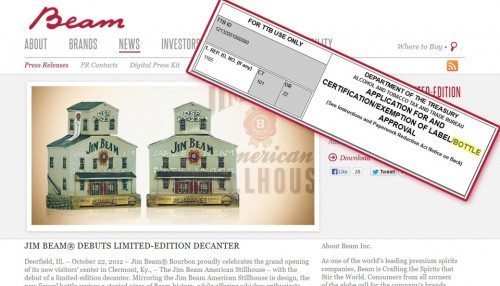Most people call them COLAs or FLAs (federal label approvals) or “label approvals.” But those terms leave out the not so minor B — as it appears in the word “bottle,” highlighted above. TTB’s pre-market approval system extends to bottles, and it is starting to seem like many people forgot about this or never knew. TTB’s bottle review probably does not cover run of the mill bottles. It is meant to cover “distinctive bottles.” The COLA form mentions that you must complete item 18.c. “if you intend to bottle distilled spirits in a distinctive container.” It’s not so easy to know what is and isn’t distinctive. The regulations use the term “distinctive” many times, and even explain the requirements for distinctive bottles, but they don’t explain when bottles are and aren’t. It is good to know that Jim Beam Brands, at least, still knows how to do this right, and can serve as a good reminder to others. The above Stillhouse Decanter certainly appears to be — on the distinctive side — for a bottle. And alas, the corresponding approval is here; item 18.c. seems to be duly completed to verify that the bottle is both distinctive and approved. Beam’s press release puts things in perspective and explains that even Jim Beam does not...
Continue Reading Leave a Commentpolicy
White Whiskey
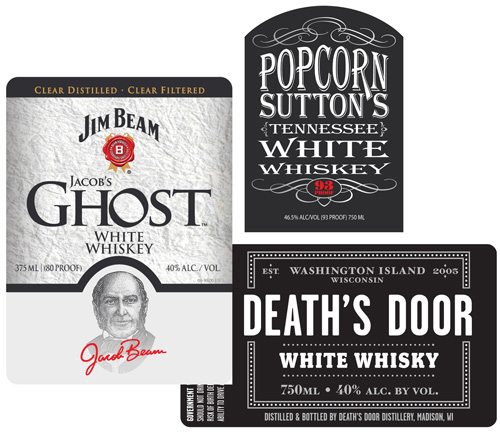
A few weeks ago we wrote about moonshine and now we have occasion to write about its close relative, White Whiskey.
Products like the above have become quite popular within the past few years, for reasons well explained by Slate:
The term white whiskey is basically a marketing name for what distillers call white dog, referring to grain-based spirits that haven’t been aged in wood to improve their flavor. [Sometimes] it’s just called moonshine, but legal sales of white dog in recent years have helped upstart microdistilleries earn immediate revenue while their whiskies age. That’s because white dog can be bottled and sold immediately after being distilled without accruing any additional storage and aging expenses. The moonshine connection has been a useful marketing gimmick for hip urban bars, but there’s one considerable downside to white dog: It tastes horrible.
At first, TTB was skeptical and pushed back a bit (saying, for example, there is no such category in the regulations). But as the trickle became a deluge, TTB began to allow white whiskey products more freely. In the light of a large number of recent approvals, it becomes clearer that TTB chiefly wants WHISKEY and WHITE on two different lines — more...
Continue Reading Leave a CommentMoonshine
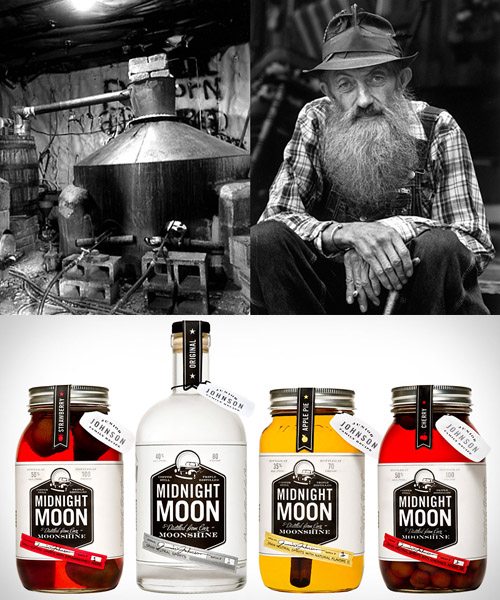
Moonshine. A word that typically conjures up thoughts of illicit high-octane liquor, clandestine stills, mason jars, potential blindness and bearded mountain men with colorful nicknames. Producing moonshine without a license is still illegal in the United States, but a large and growing number of licensed distilleries are now producing their own interpretations of moonshine. And despite moonshine’s negative associations from the past, TTB seems to have no issue allowing the word to appear on distilled spirits labels, as evidenced by the scores of moonshine labels approved so far. There is also an upsurge in approvals for moonshine’s cousins, such as white dog, white whiskey and white lightning. As far as we know, there are no specific TTB requirements to label a product “moonshine.” Apparently, moonshine can be a whiskey, a specialty product with flavors of apple or blackberry (for example), a high poof neutral spirit distilled from apples, peach brandy and even tequila. Although it appears that you can call just about any distilled spirits product “moonshine,” we think it is unlikely that TTB would allow the word on beer or wine labels anytime soon.
Continue Reading Leave a CommentOxygen Enriched Bourbon
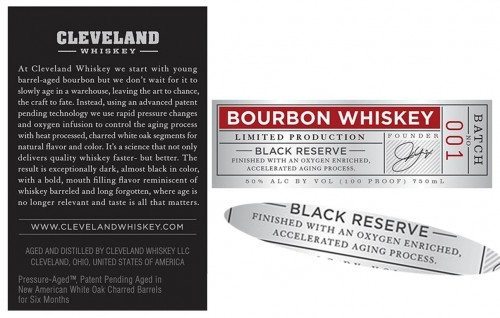
This Bourbon label caught our eye because it makes several big claims. It says:
- FINISHED WITH AN OXYGEN ENRICHED, ACCELERATED AGING PROCESS
- Patent Pending
- Pressure-Aged
- “we use rapid pressure changes and oxygen infusion to control the aging process”
- “age is no longer relevant and taste is all that matters.”
That’s a lot of envelope-pushing and innovation for one label. We happen to know a person who is both an experienced patent lawyer and an experienced whiskey distiller. So, in a future post, we hope to have him review the patent claims and assess whether this is closer to an innovation or a gimmick. The Bourbon is produced and bottled by Cleveland Whiskey, LLC of Cleveland, Ohio. The approval is here. Terressentia’s closely-related patent, also for aging spirits quickly, is described here.
Continue Reading Leave a CommentTags: legally interesting/controversial, patent, policy, processing
Shelton F's with Beer, Art, and Commercial Speech
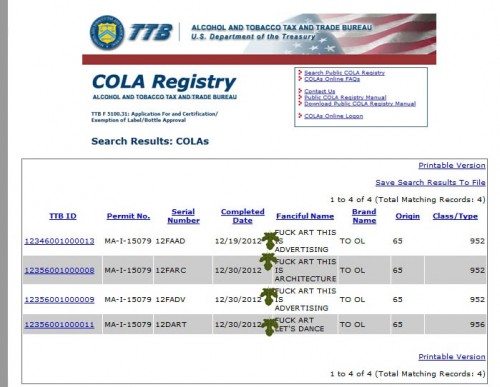
Way back in mid-December of 2012 I would have considered this Shelton Brothers COLA to be, perhaps, an aberration. But upon checking it again, today, I see a few more COLAs with the same word — arguably in need of the fig leafs above. It is hard to believe that the government did not see the word at issue. On the above-linked COLA it appears no less than three times. This may signal that, as social mores liberalize and budgets shrink, the government has bigger (or fewer) fish to fry. Clearly, it signals that Daniel Shelton does not mind pushing the envelope, or many. The Amherst College magazine unabashedly explains that, after graduating from Amherst, Shelton:
went to a prestigious law school … then clerked for a judge (on a tropical Pacific isle, of all places) and finally secured a position at a venerable firm in Washington, D.C. (but convinced Shea & Gardner that he needed to spend a year bumming around Africa before starting.) … “My Amherst education has not been wasted at all. I use it more in this business than I ever did in lawyering. I never was completely comfortable with the idea of being a lawyer, anyway.”
This creaky old regulation still prohibits any beer labeling that is...
Continue Reading Leave a CommentIs Wine Vegan?

Not that I read the PETA stuff every day, but I could not resist when I stumbled on PETA’s article entitled, “Is Wine Vegan?” It makes the point that:
The majority of people are unaware that wine, although made from grapes, may have been made using animal-derived products. During the winemaking process, the liquid is filtered through substances called “fining agents.” This process is used to remove protein, yeast, cloudiness, “off” flavors and colorings, and other organic particles. Popular animal-derived fining agents used in the production of wine include blood and bone marrow, casein (milk protein), chitin (fiber from crustacean shells), egg albumen (derived from egg whites), fish oil, gelatin (protein from boiling animal parts), and isinglass (gelatin from fish bladder membranes). Thankfully, there are several common fining agents that are animal-friendly and used to make vegan wine. Carbon, bentonite clay, limestone, kaolin clay, plant casein, silica gel, and vegetable plaques are all suitable alternatives.
For those who would prefer not to torment an animal in the course of pouring a glass of wine, The Vegan Wine Guide already lists more than 400 wines. The Vegan Vine seems like a good example. As I flipped through a few of the 400, I was not surprised to see that few...
Continue Reading Leave a CommentTags: ingredients, policy, speech
